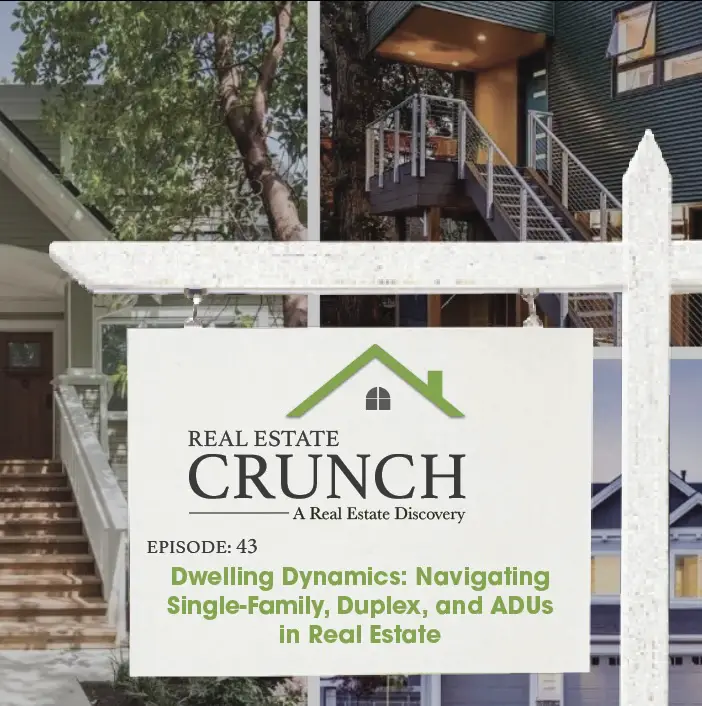Today when you’re looking at the housing market, there could be so many different words going around, such as a single-family dwelling unit, a duplex unit, or an accessory dwelling unit. These may all seem similar, but there are some differences between them.
A single-family dwelling unit is a unit that is occupied by just one household on one lot of land. A duplex is a dwelling unit where the horizontal wall is shared between two occupants, and there will be two different entrances into their individual properties. An accessory dwelling unit is a single-family dwelling unit that will be placed on their land as an accessory. An accessory dwelling unit would be considered the same ownership and house as the larger primary residence.
Table of Contents
Understanding the Differences: Single-Family, Duplex, and Accessory Dwelling Units
Navigating the housing market today can be complex, especially with terms like single-family dwelling, duplex, and accessory dwelling unit being commonly used. While they may appear similar initially, these housing types have distinct characteristics.
A single-family dwelling is a standalone unit one household occupies on its land parcel. On the other hand, a duplex consists of two separate living spaces divided by a horizontal wall, each with its entrance but housed within the same building structure.
An accessory dwelling unit (ADU) is a smaller, independent residential unit located on the same lot as a single-family home, often used as an additional living space and considered part of the same property as the primary residence.
Single Family Dwelling Unit Explained

A single-family dwelling unit is, as the name implies. It is a structure that just one householder family usually occupies.
In other words, a single-family dwelling unit usually means a building that is not attached to another dwelling unit or building. It’s usually a residential structure made for the habitation of one single-family unit.
The single-family dwelling unit usually contains one house on a permanent foundation. A single-family dwelling unit is designed to be a freestanding residential building.
A Single Family Dwelling Unit would have one owner, no shared walls, and be on its land.
Duplex Dwelling Units Explained

A duplex is a building unit that is horizontally divided. There are two dwelling units on the land, but each one would have a separate entrance.
The entrance can be on the outside or through a shared duplex entrance. The main thing about duplexes is there are two separate entrances, and the building has a common wall on one lot of land.
If there are three or four units on the same plot of land, they would be called a triplex or a quad. An ordinary wall attaches to each unit, with separate sleeping, cooking, eating, living, and sanitation facilities.
The idea of a duplex unit is that each unit is self-contained regarding ownership and all the living facilities. The units have separate entrances and separate living areas in the different units.
Accessory Dwelling Units Explained

An accessory dwelling unit is also known as an ADU. The accessory dwelling unit is the legal and regulatory term for a secondary home or apartment that shares the same building lot as a more prominent primary home.
The idea is that the accessory dwelling unit is part of the larger primary home or the single-family dwelling unit. The accessory dwelling unit cannot be bought or sold separately from the larger single dwelling unit.
An Accessory Dwelling Unit can be a guest house or a detached garage with a rental apartment above it.
Whether or not you can have an accessory dwelling unit on your property will fall under different zoning rules and regulations depending on where you live.
In other words, where you live may not allow you to have an accessory dwelling unit on your property.
If you illegally build an accessory dwelling unit on your property and want to sell or refinance it, it could cause legal problems. This is why before anybody builds an accessory dwelling unit on their property, they must look at all their local zoning rules and laws.
Also, having an accessory dwelling unit on your property could significantly increase your tax property and tax bill. Again, this will depend upon the area where you live; this will also increase your property tax for many sites because of the accessory dwelling unit.
In the last few years, an accessory dwelling unit has become very popular for many reasons.
Here are some reasons why someone may put an Accessory Dwelling Unit on their property:
- Home For An Elderly Relative – They may have elderly parents who need additional help. Instead of having them live in an assisted living facility, people may build an accessory dwelling unit on their property for the parents to live.
- Rental And Income – Other people may build an accessory dwelling unit as they want to rent out the unit to have some extra income for rental property.
- Airbnb – That’s very popular lately for people to have an accessory dwelling unit that they could rent out as an Airbnb whenever they want to have some extra income. By renting it out as an Airbnb means that they do not need to commit to having long-term renters on the property.
- Guest House – Some people will build an accessory dwelling unit specifically as a guest house. They may want separate quarters for their guests so they do not need to stay in the main house.
- Home Office – As more people have started to work from home, many have built accessory dwelling units on their property to have a home office away from their primary home.
A single-family dwelling unit, a duplex, and an accessory dwelling unit are all legal structures. Legally, they all have other rights and are looked upon differently for both mortgages, refinancing, zoning, and property taxes.
This is why anyone looking to invest in the real estate industry must also understand what each of these different units means and how they are different.
You Can Listen To Our Podcast About Dwelling Dynamics: Navigating Single-Family, Duplex, and ADUs in Real Estate Below or By clicking here.

Real Estate Crunch gives you real property and real estate information and advice. We offer a free monthly newsletter; you can sign up for our newsletter by clicking here.
We also have a weekly podcast called “Real Estate Crunch,” found on all major podcast platforms. Listen to our podcast by clicking here.
Follow us on our social media platforms – Facebook and Instagram.
Related Question
Do Modular Homes Come With Electrical And Plumbing?
When you purchase a modular home, all the electrical and plumbing should be included in the cost of the home. The modular home will need to be up to the NEC code or standards for electrical. You need to understand the quality and types of pipes and other fittings in the modular home and the manufacturer’s plumbing use.
By clicking here, you can read more about Do Modular Homes Come With Electrical And Plumbing?
Boxabl Modular Housing, Our Thoughts
Boxabl is a new housing concept that has entered every competitive housing market. Almost everyone I have spoken to has seen or heard about the Boxabl house unfolding on site.
By clicking here, you can read more about Boxabl Modular Housing, Our Thoughts

